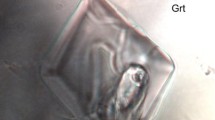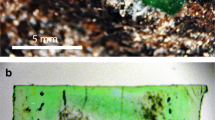Abstract
In this paper, we show that the crystallization of miarolitic pegmatites at Königshain started at about 700°C, in melts containing up to 30 mass% water. Such high water concentration at low pressures (1–3 kbar) is only possible if the melts are peralkaline. Such peralkaline melts are highly corrosive, and reacted with the wall rock—here the granite host—forming the graphic granite zone, in part via a magmatic–metasomatic reaction. With cooling, the water concentration in some melt fractions increased up to 50 mass% H2O. The melt-dominated system ends below 600°C and passes into a fluid-dominated system, the beginning of which is characterized by strong pressure fluctuations, caused by the change of OH and CO3 2− in the melt, to molecular water and CO2. We note two generations of smoky quartz, one crystallized above the β–α-transition of quartz (≈573°C), and one below, both of which contain melt inclusions. This indicates that some melt fraction remains during at least the higher-temperature portion of the growth of minerals into the miarolitic cavity, contradicting the view that minerals growing into a pegmatite chamber only do so from aqueous fluids. We show that the Königshain miarolitic pegmatites are part of the broad spectrum of pegmatite types, and the processes active at Königshain are representative of processes found in most granitic pegmatites, and are thus instructive in the understanding of pegmatite formation in general, and constraining the composition and characteristics of pegmatite-forming melts.








Similar content being viewed by others
References
Åmli R, Griffin WL (1975) Microprobe analysis of REE minerals using empirical correction factors. Am Mineral 60:599–606
Armstrong JT (1991) Quantitative elemental analysis of individual microparticles with electron beam instruments. In: Heinrich KFJ, Newbury DE (eds) Electron probe quantification. Plenum Press, New York, pp 261–315
Audétat A, Keppler H (2004) Viscosity of fluids in subduction zones. Science 303:513–516
Bakker RJ (2003) Package FLUIDS 1. Computer programs for analysis of fluid inclusion data and for modelling bulk fluid properties. Chem Geol 194:3–23
Beus AA (1966) Geochemistry of beryllium and genetic types of beryllium deposits. Freeman and Company, San Francisco
Borisenko AS (1974) Determination of sodium carbonates and bicarbonates in solutions of gas–liquid inclusions in minerals. Akad Nauk SSSR Dokl 214:917–920 (in Russian)
Borisenko AS (1977) Cryometric technique applied to studies of the saline composition of solution in gaseous fluid inclusions in minerals. Geologija i Geofizika, AN SSSR, SO, 8:16–27 (in Russian)
Brotzen O (1959) Outline of mineralization in zoned granitic pegmatites. Geol För Förh 81:1–98
Burnham CW (1979) The importance of volatile constituents. In: Yoder HS Jr (ed) The evolution of the igneous rocks: fiftieth anniversary perspectives. Princeton University Press, Princeton, pp 439–482
Candela PA, Blevin PL (1995) Do some miarolitic granites preserve evidence of magmatic volatile phase permeability? Econ Geol 90:2310–2316
Černý P, Ercit TS (2005) The classification of granitic pegmatites revisited. Can Mineral 43:2005–2026
Downs RT (2006) The RUFF™ project: an integrated study of the chemistry, crystallography, Raman and infrared spectroscopy of minerals. Program and abstracts of the 19th general meeting of the international mineralogical association in Kobe, Japan, O03–13
Ebert H (1943) Das granitische Grundgebirge der östlichen Lausitz. Hirzel, Leipzig
Eidam J, Götze J (1991) The granitic massif of Königshain-Arnsdorf (Lusatian Anticlinal Zone)—an example of a reversely zoned pluton. Chem Erde 51:55–71
Förster HJ, Tischendorf G, Rhede D, Naumann R, Gottesmann B, Lange W (2005) Cs-rich lithium micas and Mn-rich lithian siderophyllite in miarolitic NYF pegmatites of the Königshain granite, Lausitz, Germany. N Jb Miner Abh 182:81–93
Hammer J, Eidam J, Röber B, Ehling BC (1999) Prävariscischer und variscischer granitoider Magmatismus am NE-Rand des Böhmischen Massivs–Geochemie und Petrogenese. Z Geol Wiss 27:401–415
Hecht L, Thuro K, Plinninger R, Cuney M (1999) Mineralogical and geochemical characteristics of hydrothermal alteration and episyenitization in the Königshain granites, northern Bohemian Massif, Germany. Int J Earth Sci 88:236–252
Herzberg CT (1987) Magma density at high pressure: part 1. The effect of composition on the elastic properties of silicate liquids. In: Mysen B (ed) Magmatic processes: physicochemical principles, special publication, Vol. 1. The Geochemical Society, pp 25–46
Janeczek J (2007) Intragranitic pegmatites of the Strzegom-Sobotka massif—an overview. Granitoids in Poland, AM Monograph No. 1:193–201
Kozlowski A (2002) Metasomatic origin of the granitoid pegmatites. Mineralogical Society of Poland, Special Papers 20:112–116
Lange W, Tischendorf G, Krause U (2004) Minerale der Oberlausitz. Oettel, Görlitz-Zittau
London D (1992) The application of experimental petrology to the genesis and crystallization of granitic pegmatites. Can Mineral 30:499–540
London D (2004) Geochemistry of alkali and alkaline earth elements in ore-forming granites, pegmatites, and rhyolites. In: Linnen R, Sampson (eds) Rare-element geochemistry of ore deposits: Mineralogical Association of Canada Short Course Notes 17:17–43
London D (2008) Pegmatites. Can Mineral, Special Publication 10
Lu FQ, Anderson AT, Davis AM (1992) Melt inclusions and crystal–liquid separation in rhyolitic magma of the Bishop Tuff. Contrib Mineral Petrol 110:113–120
Makarov SZ (1933) Isotherme Löslichkeit und Eis-Feld des ternären Systems Na2CO3–NaCl–H2O. Z Allg Chemie 3:234–248 (in Russian)
Möbus G, Lindert W (1967) Das Granitmassiv von Königshain bei Görlitz (Oberlausitz). Abh Dt Akad Wiss, Kl Bergbau, Hüttenwesen und Montangeologie 1:81–160
Mustart DA (1972) Phase relations in the peralkaline portion of the system Na2O–Al2O3–SiO2–H2O. Dissertation, Stanford University, USA
Nývlt J (1977) Solid–liquid phase equilibria. Elsevier, Amsterdam
Oliver BG, Davis AR (1973) Vibrational spectroscopic studies of aqueous alkali metal bicarbonate and carbonate solutions. Can J Chem 51:698–702
Pavlishin V, Dovgyi SA (2007) Mineralogy of the Volynian chamber pegmatites, Ukraine. Mineralogical Almanac, EKOST Association, Moscow, Ocean Pictures, Littleton
Rhede D, Wendt I, Förster HJ (1996) A three-dimensional method for calculating independent chemical U/Pb- and Th/Pb-ages of accessory minerals. Chem Geol 130:247–253
Roeder PL (1985) Electron-microprobe analysis of minerals for rare-earth elements: use of calculated peak overlap corrections. Can Mineral 23:263–271
Sirbescu ML, Nabelek PI (2003a) Crustal melts below 400°C. Geology 31:685–688
Sirbescu ML, Nabelek P (2003b) Dawsonite: an inclusion mineral in quartz from the Tin Mountain pegmatite, Black Hills, South Dakota. Am Mineral 88:1055–1060
Thomas R (2000) Determination of water contents of granite melt inclusions by confocal laser Raman microprobe spectroscopy. Am Mineral 85:868–872
Thomas R, Davidson P (2006) Progress in the determination of water in glasses and melt inclusions with Raman spectroscopy: a short review. Z Geol Wiss Berlin 34:159–163
Thomas R, Klemm W (1997) Microthermometric study of silicate melt inclusions in Variscan granites from SE Germany: volatile content and entrapment conditions. J Petrol 38:1753–1765
Thomas R, Webster JD, Heinrich W (2000) Melt inclusions in pegmatite quartz: complete miscibility between silicate melts and hydrous fluids at low pressure. Contrib Mineral Petrol 139:394–401
Thomas JB, Bodnar RJ, Shimizu N, Chesner C (2002) The boundary layer problem and the reliability of melt inclusions as petrogenetic monitors: evidence from melt inclusions in zircon, allanite, plagioclase and quartz, In: De Vivo B, Bodnar RJ (eds) Melt inclusions: methods, applications and problems. De Frede Editore, Napoli, pp 205–209
Thomas R, Förster HJ, Heinrich W (2003) The behaviour of boron in a peraluminous granite–pegmatite system and associated hydrothermal solutions: a melt and fluid-inclusion study. Contrib Mineral Petrol 144:457–472
Thomas R, Förster HJ, Rickers K, Webster JD (2005) Formation of extremely F-rich hydrous melt fractions and hydrothermal fluids during differentiation of highly evolved tin–granite magmas: a melt/fluid-inclusion study. Contrib Mineral Petrol 148:582–601
Thomas R, Webster JD, Davidson P (2006a) Understanding pegmatite formation: the melt and fluid inclusion approach. Melt inclusion in Plutonic rocks, MAC Short Course 36, Chap. 9, pp 189–210
Thomas R, Webster JD, Rhede D, Seifert W, Rickers K, Förster HJ, Heinrich W, Davidson P (2006b) The transition from peraluminous to peralkaline granitic melts: evidence from melt inclusions and accessory minerals. Lithos 91:137–149
Thomas R, Davidson P, Hahn A (2008) Ramanite-(Cs) and ramanite-(Rb): new cesium and rubidium pentaborate tetrahydrate minerals identified with Raman spectroscopy. Am Mineral 93:1034–1042
Veksler I, Thomas R (2002) An experimental study of B-, P- and F-rich synthetic granite pegmatite at 0.1 and 0.2 GPa. Contrib Mineral Petrol 143:673–683
Voznyak DK, Matyash IV, Brick AB, Larikov AL, Mazykin VV (1984) On formation of the honeycomb quartz: ESR study. Geochimija 4:534–540 (in Russian)
Webster JD, Thomas R (2006) Silicate melt inclusions in felsic plutons: a synthesis and review. MAC Short Course Vol. 36, Chap. 8, pp 165–188
Witzke T, Giesler T (2001) Neufunde aus Sachsen (VII): Bazzit, Bertrandit, euxenite-(Y), Powellit und andere aus dem Königshainer Granit in der Lausitz. Lapis 26:43–48
Acknowledgments
The authors wish to express their appreciation to Mrs. H. Steiger for the performing of numerous high-pressure re-homogenization experiments and G. Berger for the preparation of numerous thick sections, both from the GFZ Potsdam. We thank D. Voznyak (Kiev, Ukraine) for the provision of important papers to problems of the crystallization in chamber pegmatites. We would like to thank Mr. W. Lange (Zittau) for fruitful discussion in the granite quarry “Melaune” in the Königshain Mountain and Mr. Maiwald from the ProStein GmbH & Company KG for the permission to visit the quarry. The Editor and two anonymous reviewers are thanked for their helpful suggestions.
Author information
Authors and Affiliations
Corresponding author
Additional information
Communicated by J. Hoefs.
Electronic supplementary material
Below is the link to the electronic supplementary material.
Rights and permissions
About this article
Cite this article
Thomas, R., Davidson, P., Rhede, D. et al. The miarolitic pegmatites from the Königshain: a contribution to understanding the genesis of pegmatites. Contrib Mineral Petrol 157, 505–523 (2009). https://doi.org/10.1007/s00410-008-0349-2
Received:
Accepted:
Published:
Issue Date:
DOI: https://doi.org/10.1007/s00410-008-0349-2




